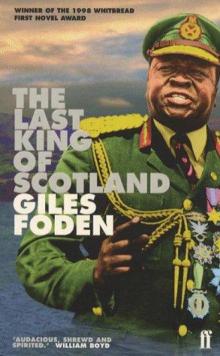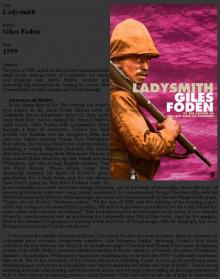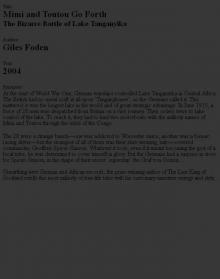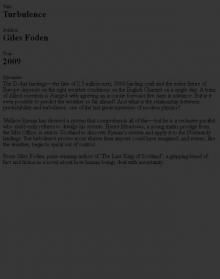- Home
- Giles Foden
2004 - Mimi and Toutou Go Forth Page 18
2004 - Mimi and Toutou Go Forth Read online
Page 18
No doubt the famous Klub Dar es Salaam, which served German beer, provided a refuge for the shipwrights. In truth, the capital of Tanzania was hardly ‘darkest Africa’ even then and they had no reason to be frightened. Once a small, mosquito-ridden village, Dar es Salaam had been transformed by the Germans into one of the most modern cities in East Africa, with new roads and docks and buildings. One of these was the Klub, founded in 1903 when Governor Götzen, returning from furlough, brought back with him 25,000 marks to found a social club. The money had been donated by a number of industrialists ‘bent on the expansion of German interests in their colonies generally’, as an early member of the Klub put it.
The Klub’s articles of association state that one in three members of the managing committee must be a ‘commercial’, i.e. not a military officer or government official. This was in order to diminish the ‘spirit of caste’: the rigid hierarchy that beset German (and British) colonial life. In his correspondence with the Imperial Government, Count Götzen stressed that this evil spirit did not exist, while accepting that the rule was very desirable. This was the social world in which the three shipbuilders from Papenburg found themselves. They may have glimpsed across the room the figure of Lieutenant-Colonel Paul von Lettow-Vorbeck, the dashing commander of German troops in East Africa. But it is unlikely they would have been given an opportunity to talk to him.
Once African stevedores had loaded 5,000 crates on to a train in Dar es Salaam, the three shipwrights were ready to start the 700-mile journey to Lake Tanganyika. They had not gone far when a fire broke out in the wagons, damaging the rigging and bending the Götzen’s propeller shaft. ‘All risks, including fire,’ said their British insurers, but the Germans never got the chance to make a claim.
About 20 miles from Kigoma the railway tailed off, unfinished. The unwieldy crates were unloaded from the train. They would be carried on African shoulders the rest of the way. This part of the journey, which took almost three months and involved thousands of porters, was nothing less than a forced march. The porters were whipped when unwilling or unable to continue. The three shipwrights were carried on a litter, an experience that at home would be reserved for the Kaiser and few others. In German East, it was the norm for white men to travel like this.
Reaching the half-built port of Kigoma on the shores of Lake Tanganyika, the shipwrights found many of their countrymen there. It almost seemed like a provincial German town, except that most provincial German towns do not have a small palace. The Kaiserhof, as it was known, had been built in case Wilhelm II should come to visit his remotest colony.
The Africans servicing the new town lived in shacks on the fringes of Kigoma. Some of the original porters stayed, but most were laid off. New labour was hired, both African and European, for there were a lot of Germans hanging around Kigoma with nothing to do, colonial adventurers hoping to make their fortune.
Anton Ruter, the foreman from Papenburg, supervised the unloading of the crates. In a makeshift shipyard by the lake, the numbered boxes were counted, then unpacked. Each piece of sheet metal or other item that emerged was checked against the foreman’s original lists. Except for two crates of deck bolts left behind in Dar es Salaam, everything was there.
Painstakingly, the Graf von Götzen was rebuilt piece by piece. The pattern of the dress rehearsal on the Ems River, back in Germany, was followed to the letter. During the rebuilding the three shipwrights lived in huts next to the shipyard, each engaging his own personal staff. For all that, it was not a luxurious life. At one point they even ran out of shoes.
Around this time the Götzen was officially transferred from the German East African Railway Company to the military authorities; its value at this point is stated in German documents as 750,000 marks—approximately £36,765. The rise from the book cost of £20,000 was due to the cost of transport to and reconstruction at Kigoma.
War broke out in Europe on 4 August 1914. On 26 August von Lettow sent Kapitan zur See Gustav Zimmer to Lake Tanganyika to take charge of the German naval contingent: his fleet would consist of the Kingani, the Hedwig and the emerging star of the show, the Grajvon Götzen. By the end of 1914, ‘the ship that came by train’, as it was known, looked like a ship again. An armed ship: the two guns from the disabled Königsberg having been installed and tested.
On 1 June 1915 the Götzen was launched, making a 50-hour journey to Bismarckburg (now Kasanga), a German-held town at the south end of the lake. In his report on this trial run, Zimmer mentioned that the British-made steering mechanism connecting the wheel to the rudder was defective, causing the ship to roll and list, but this had been rectified. A related issue was the draught (how deep in the water she sat), which was too shallow. Zimmer recommended it be increased by adding two metres to the length of the funnel.
Eight months later, the day after the sinking of the Hedwig, the Götzen steamed past the British camp at Albertville looking for her sister ship. Hearing shouting, Dr Hansch-ell and Odebrecht left the breakfast table and went out on to the ‘quarterdeck’ in front of Spicer’s hut. They gazed at the giant steamer, the noise of her propellers clearly audible for many miles as they chomped the water.
The Iron Cross fluttered as the Götzen moved slowly along the horizon, spreading the foaming, twinfold ribbon of its wake over the surface of the lake. Her charcoal-burning furnace left a curlicue of black smoke above the blue water. On deck, next to bulkheads fore and aft, clusters of seamen stood round the big guns, watching and waiting for the order to fire. It was an oceangoing-sized ship, all screws and steel plate below, steel rigging and swinging derricks aloft. How had the Germans cast and hammered all that metal out here in the bush, then fitted it all together?
The doctor and Odebrecht watched as Wainwright and the crews of Mimi and Fifi ran down to the harbour (Toutou was still out of commission). They heard Mimi’s engines start up and saw smoke begin to rise out of Fifi’s funnel as Lament and Fundi stirred her banked-up fires. Meanwhile, Dudley’s whippet-thin figure ran to Spicer’s hut to tell him that battle must be joined again. The Götzen draw parallel with the camp, at which point Byron Farwell takes up the story:
Spicer-Simson, standing on his verandah, watched it intently through his glasses, while Dudley, beside him, pleaded with him to order an attack. In the harbour, Fifi was getting up steam and Mimi was preparing for battle, but Spicer let the moment pass. The Graf von Götzen looked formidable; he had already earned his place in history. While Dudley argued, the Graf von Götzen altered course and disappeared.
In the middle of the argument Spicer simply turned abruptly on his heel and went back into his hut. Cursing him, Dudley strode past Odebrecht and the doctor—and without looking at them, says Shankland, ‘went to the edge of the bluff and put his hands to his mouth to form a trumpet and shouted, ‘As you were! As you were!’ He waved to the crews to come up, and went off down the path to meet Wainwright.’
Odebrecht watched the whole scene from the cliff’s edge, but remained silent. Then comes the most dramatic moment in Shankland’s marvellous book: ‘[As] at last he turned and gazed straight at the Doctor, not a muscle of his face moved. Then he walked quickly away and entered the hut where he was billeted.’ Three days later, Odebrecht was marched to a prisoner-of-war camp, still wearing the doctor’s mosquito boots.
In the interim, Fundi had turned up at the hospital tent with terrible burns on his hands and shins from stoking Fifi’s furnace during the attack on the Hedwig. Lament had only noticed these injuries as they were preparing for the aborted attack on the Götzen. Fundi’s body was a suppurating mass of blisters, especially the tops of his feet. In the service of his new colonial masters, he had raked out the hot ash directly onto them. The romantic adventure of Mimi and Toutou was well and truly over.
TWENTY-ONE
Morale plummeted over the next few days. The men wanted to go out and fight; an instinct that the reappearance of the Götzen rubbed raw and angry. Twice again she had been spotted on the horizon, the te
mptress, casually riding the swell. Still Spicer refused. He gave no reason, but perhaps he believed he had fulfilled his orders by sinking the Hedwig and it was foolish to pitch Mimi and Toutou (now repaired) against such odds.
It was a time of signs and wonders. Walking through the bush, Dr Hanschell had been delighted to come across a carpet of golden butterflies that stretched for yards around. A few days later he was less pleased when he awoke to find a brown-and-pink, diamond-patterned snake near the wall of his hut. He stamped his foot and it fled outside. Curious, the doctor followed. The snake had gone. On the lakeside opposite, the sun was rising behind Mount Kungwe at exactly the point where it reached its full height of 8,620 feet; its notched, double-topped head embodying the greatest demon of the land. A few days later news came through on the radio that Spicer (with whom the Admiralty was generally well pleased), Wainwright (for carrying out Spicer’s orders to the letter) and Lamont (for running Fifi’s engines without a stoker) had all been awarded medals. On hearing of his award Lamont disappeared to his workshop. He emerged at nightfall, clutching a brass medal on one side of which he had engraved the words FUNDI RN (Royal Navy) and on the other HMS FIFI, 9 FEBRUARY 1916. But who would present it? As Shankland tells us:
The Black Squad↓ went in a body to Spicer and asked him to present it at a ceremonial parade. Spicer gave permission for the parade, but thought it wouldn’t be tactful for him to take part in it personally. Marapandi produced a broad ribbon of red, white and blue from which he suspended the medal.
≡ The African connections of the expedition.
In the end, Lamont presented the award himself. After it had been hung round his neck, a beaming Fundi acknowledged the cheering, clapping crowd and went round shaking everyone’s hand, Spicer’s included.
Not long after this spontaneous display of gratitude, Spicer abruptly left Albertville. He said he was going down to Stanleyville and left Wainwright in charge, adding that he was not under any circumstances to attack the Götzen unless the German ship began shelling the camp.
Spicer was away for months. The expedition heard that he had gone down to Leopoldville (Kinshasa), the Belgian capital on the western Congo, more than 1,500 miles away. Nobody knew quite what he was up to,↓ but on his travels Spicer received a telegram from General Northey, who commanded British troops in the region, asking him to attack the Götzen.
≡ He tried to commandeer a boat belonging to the British consul at Banana on the mouth of the Congo, but was overruled in a stern missive from Bonar Law at the Colonial Office.
Spicer replied that he would not, because he thought the chances of success too slim.
It was during Spicer’s absence that the statues started to appear. The Holo-holo had been so impressed by the sinking of the Hedwig, writes Magee, ‘that they moulded images of the commander in clay (and good likenesses, too) which they worshipped in their villages as their new ju-ju’. Dr Hanschell first heard about them when Rupia had burst into his hut as he was writing some letters home.
‘Navyman God!’ said his servant with a mysterious smile. When the doctor asked him what on earth he was on about, Rupia merely repeated, ‘Navyman God!—You come see!’
He followed Rupia out to a small clearing in the bush, where they found a clay statue about two feet high with short legs and arms but a well-modelled face and torso. The doctor told Shankland how he ‘went up close to it and found that the face was a recognisable caricature of Spicer with a pointed beard and wearing a sun-helmet. It was grasping with both tiny hands an object representing a pair of binoculars. Tiny incisions marked the tattooed snakes and butterflies on the chest and forearms, and between the squat little thighs there was a bit of native loin-cloth.’
Later, the Catholic missionary from the Order of the White Fathers came to Dr Hanschell for quinine as he prepared to return to his church at Karema (established in 1885, the mission station was formerly a vast transit camp for slaves en route to Zanzibar). The White Father confided to the doctor that these statues had been appearing all along the lakeshore and inland as well. He accused Spicer of undoing all his good work as the tribe reverted to its old ways: there had been some cockerel feathers and snakeskin on a platform before the statue and some stones smeared with blood. The elderly White Father had spent many years trying to persuade the Holo-holo to give up cruel practices and idolatry and embrace Jesus Christ—and now a fetish of a European had been set up within a few miles of his mission!
‘I suppose they think of me as some kind of great chief witch doctor?’ Dr Hanschell asked the despondent missionary.
‘No—that’s not their name for you,’ replied the White Father, at last breaking into a smile. ‘What they call you, as nearly as I translate it, is something like ‘Harmless Village Idiot’. Poor doctor! No statues for you!’
Why had Spicer, in particular, inspired such worship? The snakeskin by the statue is of relevance here, and it relates to the spirit of Mount Kungwe. Mkungwe had two troublesome sons, Katavi and Lubadyu. According to Dr Egon Kirschstein in a 1937 edition of Tanganyika Notes and Records :
The tale tells of a quarrel between Katavi and his father Kungwe long long ago, whereby Katavi split the father’s head. That notch is visible today. Kungwe did not pardon the insult, but ordered Katavi to leave the country. In his anger Katavi threatened to create another Tanganyika somewhere else. Old Kungwe smiled contemptuously when he heard of such a boast by the outcast. Katavi, however, fulfilled his threat and made a new Tanganyika further inland, in that part of the country which is now called the Katavi plain.
Katavi’s brother Lubadyu was similarly outlawed, so enraging Kungwe that he picked him up and threw him over to the other (Congolese) side of Lake Tanganyika. ‘The effort was so great,’ according to C. C. O’Hagan,↓ ‘that Mkungwe lay down and in the early morning he can be clearly made out from the north lying on his back, his head towards the water, his knees raised with his hands clasped over his stomach.’
≡ A British colonial official who climbed Mount Kungwe in May 1939.
Mkungwe has never risen again. Over on the Albertville side, Lubadyu made mountainous country, too, when he fell; but the shock of the fall was so great that he disintegrated—‘so that only his bulk, but not his form can now be made out’. This myth of the division of a single land mass into two parts, each with a divine authority subordinate to a greater power, may be related to a theory advanced by the explorer Sir Henry Morton Stanley—namely that early humanoids were witness to the tectonics of the Rift Valley (which produced Lake Tanganyika) and retained that distant memory in their myths and legends.
Holo-holo mythology has a strict hierarchy. Just as the spirit Mkungwe reported to the cosmogonic god Kabedya Mpungu (who does not concern himself with merely human affairs), so the errant sons reported to Mkungwe. Doubles play an important part in these legends. For instance, on appeal, the ancestral spirits of human twins (known as Migabo) would act as intercessors to Katavi and Lubadyu, who would pass this appeal to Mkungwe and so on up the chain to Kabedya Mpungu. The Migabo were usually approached and called upon after a vision or dream of snakes. Seeing snakes meant that the spirits had been neglected.
Add to this a related story about a monster in the lake (which was thought of as a giant snake) and we come closer to understanding why the tattooed Spicer was so revered. The snake designs on his arms and thighs plugged him directly into the mythic consciousness of Holo-holo society.
His main claim to holiness, however, was his victory over the Germans, who were disliked by some Holo-holo for violating a sacred site. In 1925 G. W. Hatchell wrote about visiting Kafishya, near Karema on the former German side of Lake Tanganyika. Here the Holo-holo had once stored wooden images of the old kings of the people, which they brought over when they crossed from the Congolese side:
It was said that a German, Lieutenant Bishoff, having reason to suspect that Kafishya was the scene of human sacrifice and believing that he had found human blood on the images took them away
and destroyed them. Certain of the older people at Karema however believe that many of the images had been sent to Berlin.
According to Hatchell, a sect of Holo-holo women keep the skulls of the dead kings safe from any further interference at another site on the lakeshore. I heard the same story during an expedition to the lake in 2003 and it cast some light on Spicer’s deification.
When their kings became infirm, the Holo-holo would kill them. This was done with full ceremony, but in secret by a witch doctor. As part of the ritual, the new king would emerge from the same hut in which the old king had been murdered and thereby take his place (the dead king’s skull would then be kept as a sacred object). This symbolism may well have played its part in the deification of Spicer. Having killed the ‘old king’ (the Germans), he took on their power. It is a variant of the Fisher King myth made famous by Sir James Frazer’s The Golden Bough (1890–1915).
Modulations of this ritual can be found in various parts of the Rift Valley and Nile basin. While it seems to be geographically focused on the nexus of the Great Lakes, it is the wellspring of many myths of renewal that travelled far and wide. During their explorations of Lake Tanganyika in November and December 1871, Stanley and Livingstone were told a fable by their boatman Ruango which reiterated many of the cultic motifs, including fish and secret enclosures, that Jesse Weston believed underpinned medieval romances such as Sir Gawain and the Green Knight and were furthermore the bedrock of the Holy Grail story. Weston’s From Ritual to Romance (1918) is said to have exerted a profound influence on T. S. Eliot.

 The Last King of Scotland (1998)
The Last King of Scotland (1998) Zanzibar
Zanzibar Turbulence
Turbulence The Last King of Scotland
The Last King of Scotland 1999 - Ladysmith
1999 - Ladysmith 2004 - Mimi and Toutou Go Forth
2004 - Mimi and Toutou Go Forth 2009 - Turbulence
2009 - Turbulence